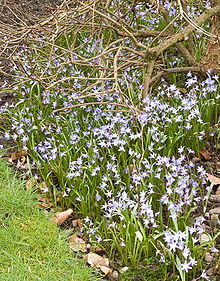- Chionodoxa siehei
-
Chionodoxa siehei 
Scientific classification 
Kingdom: Plantae clade: Angiosperms clade: Monocots Order: Asparagales Family: Asparagaceae Subfamily: Scilloideae Genus: Chionodoxa Species: C. siehei Binomial name Chionodoxa siehei
StapfChionodoxa siehei or Siehe's Glory-of-the-Snow is a bulbous perennial from west Turkey flowering in early spring. After flowering, it goes into dormancy until the next spring. It seeds readily to form colonies.
Contents
Description
 Self-sown carpet of Chionodoxa siehei under a deciduous shrub, flowering in early April in the West Midlands, England.
Self-sown carpet of Chionodoxa siehei under a deciduous shrub, flowering in early April in the West Midlands, England.
This is the commonest species grown in gardens, where it is often wrongly called C. luciliae. Some botanists consider C. siehei to be the same species as C. forbesii, which is then the correct name. The Royal Horticultural Society treats them as distinct.[1]
Like all members of the genus Chionodoxa, the bases of the stamens are flattened and closely clustered in the middle of the flower. In the related genus Scilla, the stamens are not flattened or clustered together.[2] The differences are not considered by some botanists as sufficient to create a separate genus, so they include this species in Scilla.[1]
Each bulb produces two leaves, up to 12 cm long and 2 cm wide, and at most one flowering stem, up to 10.5 cm long. The flowers are produced in a broadly pyramidal raceme, with up to 12 flowers per stem. The lower ones face outwards, the upper ones face upward. Each flower is up to 3 cm across, with individual tepals 1.3 cm long. The base of each tepal is white (as are the stamen filaments), producing a white 'eye'. The outer part of the tepals is violet-blue.[3]
Garden use
C. siehei can be bought as dry bulbs (often under the alternative names C. luciliae or C. forbesii) and planted while dormant in late summer or early autumn at a depth of 8–10 cm. It requires light when in growth, but can be grown under deciduous trees or shrubs, as the foliage dies down after flowering. It will flower in early to mid Spring. The common blue form of C. siehei seeds freely in many gardens, creating large colonies.
C. siehei was awarded the RHS Award of Garden Merit (H4 – hardy outdoors throughout the British Isles) in 1993, which was re-confirmed in 2004.[4] The variety alba has white flowers, and the cultivar 'Pink Giant' has pink flowers with white centres.[2][5]
Notes and references
- ^ a b Dashwood & Mathew 2005, p. 5
- ^ a b Mathew 1987, p. 25
- ^ Dashwood & Mathew 2005, p. 7
- ^ Dashwood & Mathew 2005, p. 3
- ^ Beckett & Grey-Wilson 1993
Bibliography
- Beckett, Kenneth; Grey-Wilson, Christopher, eds. (1993), "Chionodoxa", Alpine Garden Society Encyclopaedia of Alpines, Vol. 1 (A-K), Pershore, UK: AGS Publications, pp. 284–5, ISBN 978-0-900048-63-0
- Dashwood, Melanie & Mathew, Brian (2005), Hyacinthaceae – little blue bulbs (RHS Plant Trials and Awards, Bulletin Number 11), Royal Horticultural Society, http://www.rhs.org.uk/getattachment/04d1dd16-01be-4c31-9510-8a081dfa23b0/Hyacinthaceae---Little-Blue-Bulbs-Bulletin.aspx, retrieved 19 February 2011
- Mathew, Brian (1987), The Smaller Bulbs, London: B T Batsford, ISBN 978-0-7134-4922-8
- Mathew, Brian (2005), "Hardy Hyacinthaceae, Part 2: Scilla, Chionodoxa, xChionoscilla", The Plantsman (New Series) 4 (2): 110–21
Categories:- Scilloideae
- Ephemeral plants
Wikimedia Foundation. 2010.
